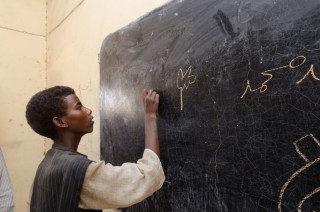
(c) Global Partnership for Education
19-04-2016, GPE | The recent conference on the role of education in building social cohesion and sustainable peace, co-hosted by UNICEF, the Global Partnership for Education (GPE) and the World Bank, comes at a critical time. Almost 250 million children currently live in regions and countries affected by fragility and violent conflict.
According to the 2015 Global Peace Index, the intensity of internal armed conflict has increased dramatically, while the cost of violence around the world reached a staggering US$14.3 trillion in 2014. From Syria to South Sudan, complex protracted crises are endangering the progress made in development and the lives and future of children around the world.
A research initiative to learn about education and peace
UNICEF’s Peacebuilding, Education and Advocacy initiative – Learning for Peace – was launched in 2012 with the support of the government of the Netherlands to address these pressing concerns – and ask: how can we use education and social services to contribute to peacebuilding, social cohesion and resilience?
The program invested in research to address the significant gap in knowledge and evidence on the contribution of education to peacebuilding. Key results from the program were shared at the conference and generated exciting discussions on the different issues around education for peacebuilding – policies, teacher and youth agency, as well as gender, education inequality, and conflict prevention. While results are still coming in, some of the initial findings are astounding
The link between education inequality and conflict
In partnership with FHI 360, UNICEF released a study that found the likelihood of violent conflict doubles in countries with high levels of inequality in education. The global study, Does Horizontal Education Inequality Lead to Violent Conflict?, looked at more than 100 countries over a 50-year period (1960-2010), and analyzed the relationship between educational attainment, education inequality and incidences of conflict. At the conference our moderator Femi Oke called this the “mic drop” moment: we can now categorically say that there are direct links between the equitable delivery of education services and conflict.
Researchers from the universities of Amsterdam, Sussex and Ulster (our Research Consortium) presented findings around integrating education into peacebuilding processes at global and country levels and the crucial, and often overlooked, role of young people and teachers in building peace.
Another area of research previously unexplored was the relationship between education and transitional justice. UNICEF collaborated with the International Center for Transitional Justice (ICTJ) on a research report Education and Transitional Justice: Opportunities and Challenges for Peacebuilding. The report found that education is an important instrument for remembering and addressing the past, and that it can play a pivotal role in understanding the legacy of trauma, establishing peace and preventing the recurrence of conflict following periods of mass violence.
We also joined forces with the Harvard Humanitarian Initiative to work out how to measure social cohesion. Stay tuned for more on this.
Multiple entry points in different countries for the research
Beyond the investment in research, Learning for Peace also developed new and adapted education programs in 14 countries. Some key approaches included:
- working with Early Childhood Development (ECD) centers to mend divides by bringing communities together over the shared goal of child wellbeing like in Cote d’Ivoire
- rethinking the role of men and women in peacebuilding
- looking at mother tongue language programs in places like Myanmar
- engaging young people to be active agents of change in their communities, and
- working closely with governments to include peacebuilding and conflict-sensitivity in education-sector plans.
While the Learning for Peace program officially ends in June 2016, the research and evidence collected will continue to inform future programming and support the way forward in the humanitarian agenda.
It’s clear from the evidence coming in from countries, regions, and partners, and from this significant growing body of research, that there is no doubt that effective and equitable education can make significant contributions to social cohesion and peace.
At a time when the global community is faced with diverse and widespread violent conflicts, it’s essential we go beyond our usual service delivery and work together to find ways to leverage education services in a way that contributes to the mitigation of conflict factors. This will enable us to better meet the needs of children and communities in crises and ultimately build a safer and more peaceful world for generations to come.
For more on the Learning for Peace program:
- Visit: learningforpeace.unicef.org
- Join the conversation and spread the word by using the hashtag #learningforpeace
- Share your own stories of education and peace – you can tweet at us at @UNICEFEducation
Article by Friedrich Affolter, Manager of UNICEF’s Peacebuilding, Education and Advocacy Programme (PBEA) at UNICEF Headquarters in NY. The programme is implemented in 14 fragile and postconflict countries in Southereastern and Western Africa, the Middle East, Central and South East Asia
